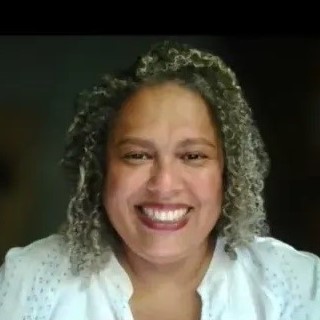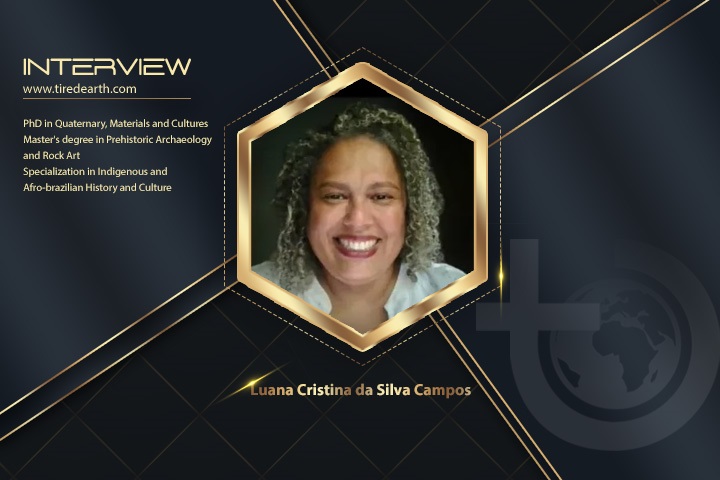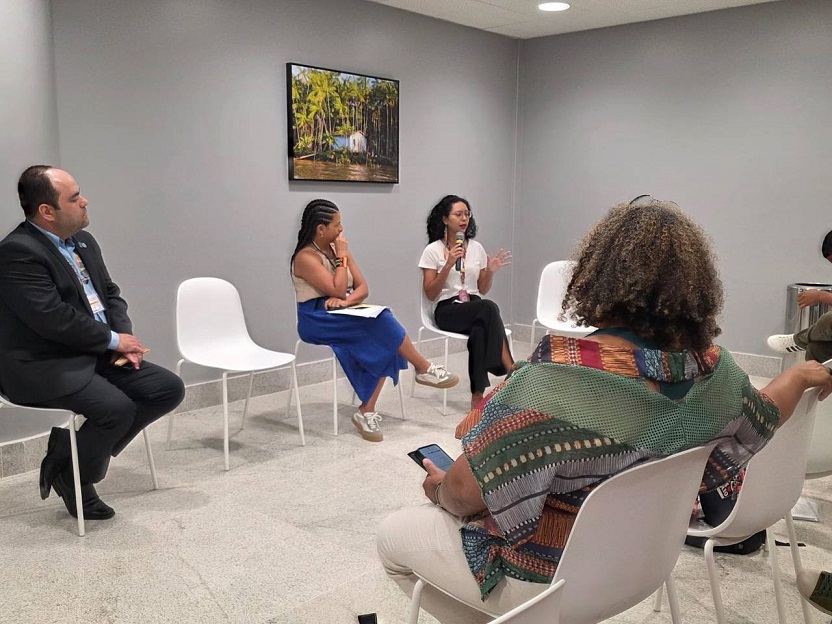11 Nov 2025

Luana Cristina da Silva Campos
Brazil

1. Tell us about your personal and academic journey that led you to your career at UFMS.
I am a Black woman from a low-income family who studied in public schools my entire life. I worked during the day and studied at night to earn my degree in History at the Federal University of Mato Grosso do Sul (UFMS). Later, I pursued a master’s degree in Portugal with a scholarship from the Municipality of Mação and invaluable support from the Instituto Terra e Memória. I completed my Ph.D. at the University of Trás-os-Montes e Alto Douro, also in Portugal, with a full doctoral scholarship from CAPES, Brazil’s national research agency.
After returning to Brazil, I worked as a postdoctoral fellow at the Environmental Studies Center at UNICAMP and served as a research fellow for the Professional Master’s in Preservation of Cultural Heritage at IPHAN, Brazil’s national heritage institute. Before joining UFMS, I also taught as a visiting professor at the State University of Goiás (UEG).
In 2023, after years of study, resilience, and dedication, I was approved in a national public competition to become a professor of archaeology at UFMS, where I now work to bridge research, teaching, and community-based heritage initiatives. My path has always been guided by the conviction that knowledge is a form of resistance and that education can transform both lives and landscapes.
2. What are your responsibilities at UFMS?
In Brazil, universities are based on a tripartite structure: Teaching, Research, and Extension. I am involved in all three.
In teaching, I lecture in the undergraduate programs in History and Law, and in the Master’s Program in Social Anthropology, where I am part of the Archaeology track.
In research, I coordinate two main projects, including one focused on the archaeological mounds of the Pantanal, which are ancient earthworks built from terrestrial gastropod shells to create elevated ground in a flood-prone environment.
In extension, I lead five community-based projects that bring local and regional populations closer to academic life through workshops, guided visits, and participatory dialogues. One of them, Conhecendo a Cultura Material (“Knowing Material Culture”), offers educational circuits on prehistory for school students. Another, Diálogos sobre Patrimônio Cultural e Ações Climáticas (“Dialogues on Cultural Heritage and Climate Action”), supported by IPHAN and the ICOMOS Climate Change and Heritage Committee, has held workshops across Brazil’s main biomes to inform the creation of the Brazilian Charter on Cultural Heritage and Climate Change.
I am also involved in Preserving Legacies, an international project supported by the National Geographic and ICOMOS International, focusing on cultural resilience among the Guató Indigenous people in the Pantanal. Preserving Legacies was awarded the Global Center on Adaptation’s (GCA) Local Adaptation Champion Award for Citizen Science at COP30 in Belém, Brazil. More recently, with support from the ALIPH Foundation, I have been leading efforts to transform inhabited archaeological mounds into resilience areas that mitigate wildfire impacts in the Pantanal.
3. How are you involved with the Climate Heritage Network?
I serve as the Secretary of the ICOMOS-Brazil Scientific Committee on Climate Change and Heritage. I first learned about the Climate Heritage Network (CHN) through my dear colleague Andrew Potts, whom I met during an ICCROM NetZero event in Italy. Since then, our committee has joined the network and actively collaborated with CHN on advocacy, research, and international dialogues.
Through this partnership, we have strengthened Brazil’s presence in global heritage and climate discussions, emphasizing the voices of local communities, traditional knowledge holders, and Indigenous peoples who are on the frontlines of climate adaptation.
4. Tell us about your schedule in the COP30 Green Zone.
At COP30, we will participate in three main activities that reflect much of the work developed by the Cultural Heritage and Climate Action Dialogues program—an initiative that culminated in the launch of the Brazilian Charter on Cultural Heritage and Climate Change.
📅 November 12 – Green Zone | 2:30 PM–6:00 PM
We will host the panel “Cultural Heritage and Climate Change,” coordinated by the Scientific Committee on Climate Change and Heritage of ICOMOS-Brazil and the Federal University of Mato Grosso do Sul (UFMS).
The panel will feature:
Leandro Grass – President of IPHAN (National Institute of Cultural Heritage of Brazil)
Aline Vieira de Carvalho – Culture Committee of Pará / NEPAN-UNICAMP
Leonardo Chaves de Carvalho – Director of Sustainability at UFMS
Ave Paulus – Focal Point of the ICOMOS Climate Action Working Group
Lucimara Letelier – Vice-President of ICOM Sustain
Moderation and coordination:
Luana Campos – ICOMOS-BR / UFMS
Aline Vieira de Carvalho – ICOMOS-BR / NEPAN-UNICAMP
(Location: Creative Economy Pavilion, Coworking Room 03)
📅 November 14th | 1:15 PM – 2:45 PM
Our colleague Aline Vieira de Carvalho will represent Brazil at the event “What can we learn from traditional climate-resilient buildings,” organized by ICOMOS, DGNB, CHN, and Architecture 2030 — a dialogue on traditional knowledge and climate-resilient architecture.
📅 November 21 – Museum of the Amazon
Two additional sessions will take place at the Museum of the Amazon, with support from ICOM Brazil:
Panel: Museums – From Local to Global, moderated by Diego Vaz Bevilaqua (ICOM Brazil), with the participation of Lucimara Letelier, Ursula Vidal, Helena Pinto Lima, Rachelle Kalee, William Gamboa Sierra, and Gunjan Nanda.
Panel: Emerging Challenges of the Brazilian Charter of Cultural Heritage and Climate Change, with Aline Vieira de Carvalho (ICOMOS-BR), Mauro García Santa Cruz (Latin America and Caribbean Climate Heritage Network), Ave Paulus (ICOMOS), Irleuza Apiaká (Apiaká Indigenous Association) and Denilson Batista (Quilombo de Macapazinho).
Together, these sessions reflect the plural and intersectional approach of our work – linking the academic world, heritage institutions, indigenous and Afro-descendant communities, and global networks to promote climate and cultural resilience.
_1763294493.jpg)
5. COP30 is being called the “COP of Adaptation”. How does this apply to culture and heritage?
Adaptation is perhaps the concept that best defines the cultural heritage of the Global South. When we think about cultural heritage and climate change, we must recognize a two-way relationship: heritage sites are directly affected by extreme events and need to adapt—but, more importantly, heritage itself embodies the adaptive knowledge that has allowed communities to persist for centuries.
These adaptive mechanisms are deeply rooted in local traditions and relationships with the land. In Brazil, we see this in the archaeological mounds built by the Guató people in the Pantanal, which raise living areas above seasonal floods; in the ancestral routes of the Quilombo do Camburi in São Paulo, which reflect ecological coexistence; and in the Engenho do Murutucu Ecoarchaeological Site in Pará, where cultural memory and environmental adaptation are intrinsically linked, among other examples.
Culture is not only a victim of climate change—it is also a source of solutions. Recognizing this means placing cultural heritage at the center of adaptation strategies, especially in regions where community knowledge is the first and most resilient line of defense.
6. Tell us about your initiatives to integrate culture into climate policies in Brazil.
At the national level, our actions have been developed through a strategic partnership between ICOMOS-Brazil, IPHAN (Brazil’s National Heritage Institute), and ICOM. Together, we launched the Brazilian Charter on Cultural Heritage and Climate Change, a landmark document that consolidates Brazil’s commitment to integrating culture into climate adaptation and mitigation policies.
The Charter was built through participatory workshops held across Brazil’s main biomes — the Pantanal, Cerrado, Caatinga, Atlantic Forest, Amazon, and Coastal regions — involving Indigenous leaders, Afro-Brazilian communities, researchers, and government agencies. It outlines the risks faced by cultural heritage, identifies local adaptive capacities, and proposes cross-sectoral strategies to ensure that cultural heritage becomes a central pillar of climate governance.
This process not only generated a policy document but also created a national dialogue platform that continues to shape public discussions and institutional actions related to heritage and climate justice in Brazil.

7. In this article, some of the climate challenges in the Amazon are detailed: Lamont-Doherty Earth Observatory joins COP30 with Science & Art. What do you think?
It is absolutely necessary — and deeply inspiring. We need more initiatives like this, and, more importantly, we need to share them broadly. Art and science together have the power to communicate climate urgency in ways that transcend technical barriers.
That is why we are starting a collaboration with the Ministry of Culture of Brazil to build a national database of cultural and scientific experiences related to climate action, allowing projects like this one to inspire others and strengthen collective resilience.
8. Where can the public follow your events digitally if they are not in Belém, Brazil?
Unfortunately, our sessions at COP30 will not be livestreamed. However, we will share the key outcomes, images, and reflections on our social media channels:
Instagram: @mudclima
YouTube: MudClim Channel
These platforms are part of our broader effort to make the dialogue between culture and climate action accessible to a wider audience.
9. Would you like to add anything else?
Yes — I invite everyone to read and share the Brazilian Charter on Cultural Heritage and Climate Change, available at:
👉 https://climateaction.icomos.org/en/news/brazilian-charter-on-cultural-heritage-and-climate-change/
The Charter represents a collective voice from Brazil and Latin America, emphasizing that heritage is not static — it is a living system of knowledge, resilience, and adaptation.
10. How can people contact you?
Email: luana_campos@ufms.br
Instagram: @lapan.ufms
I am always open to collaborations, dialogues, and joint initiatives that connect culture, science, and community toward a more just and resilient future.



Comment